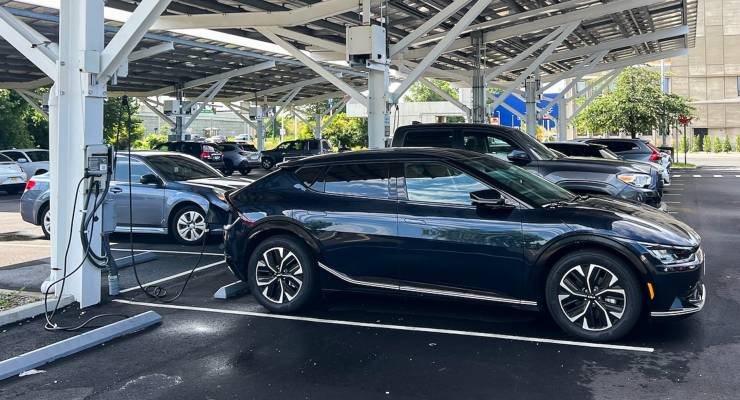
As anyone who has considered buying an electric car, or even a hybrid, is aware, the first thing you have to think about is the waiting list.
A handful of models are readily available, but for most of those sold in Australia, the waiting time can run into months. And used EVs are as scarce as hen’s teeth.
Unsurprisingly, Australia is among the world’s laggards in the take-up of EVs, which account for around 6.5% of new sales, with hybrids another 10.5%. Given the longevity of Australian vehicles (typically 10-20 years), the prospect of electrifying our car fleet in the early 2030s is slipping away.
In New Zealand, by contrast, sales are booming. EVs (12.5%) and hybrids (41%) make up a majority of new car registrations. This contrast is partly due to more generous subsidies. But far more important is the fact that New Zealanders are free to choose whatever vehicles they like, including imported used cars. There is no need to buy from an authorised manufacturer’s representative, as long as the vehicle’s compliance with safety and emissions standards is verified by an entry certifier, such as the Automobile Association.
New Zealand removed restrictions on imports as the car assembly industry wound down in the 1980s and 1990s. By contrast, while the Abbott government moved to shut down the remains of the car industry in 2015, it did nothing to upset the cosy market arrangements of foreign car manufacturers and their local distribution networks. This hasn’t changed under its successors.
The only way to import a vehicle in Australia without going through the established networks is through the “specialist and enthusiast vehicle (SEV) scheme”. As the name implies, although “low emissions” is one criterion for inclusion, the scheme is not designed to encourage mass adoption. Quite the opposite.
Nevertheless, the SEV scheme provides a possible starting point for allowing Australians to bypass the established dealer network. The national electric vehicle strategy consultation paper released in September 2022 recognised this and noted that: “Some stakeholders have called for regulation to be relaxed to enable a wider range of second-hand and new EVs to be imported.”
The idea has been recommended to government previously, such as by the Productivity Commission and the Australian Competition and Consumer Commission in 2014, and the Harper review in 2015.
A number of submissions endorsed and expanded on this point. But when the strategy was released in April 2023, the issue wasn’t even mentioned. Instead, it expressed the pious hope that increased government purchases of EVs would “incentivise importers to increase the range of EV models available”.
It’s not hard to explain this outcome. The Federal Chamber of Automotive Industries (FCAI) has been lobbying hard against any competition for its members, using the pejorative term “grey imports”.
“In our view, grey imports should be restricted to specialist and enthusiast people; they should be extremely rare and limited in their volume because they should not be part of the mainstream market,” said FCAI chief executive Tony Weber.
At the same time, while shifting its rhetoric to match the changing political winds, the FCAI has surreptitiously undermined any move to a genuinely effective EV strategy.
Having apparently capitulated to the FCAI on maintaining import restrictions, the Albanese government is — as on so many issues — reduced to restating the positions of its predecessor. Asked about the topic, a spokesperson claimed credit for the fact that: “It’s become easier for industry to import new and second-hand specialist and enthusiast vehicles under the 2021 road vehicle standards legislation.”
Alert readers will notice that these changes were introduced under the Morrison government, although their implementation has largely taken place since the 2022 election.
More generally, this is yet another instance where the Albanese government has been unwilling to confront powerful business lobbies, and happy to do the minimum possible when it comes to climate policy.
Until recently, polling suggested this softly-softly approach was paying electoral dividends, even if there was little in the way of policy achievement to show for it. But having given its supporters few reasons for enthusiasm, the government can’t count on their loyalty when times turn bad.
Have you been stymied in buying an EV? Let us know by writing to letters@crikey.com.au. Please include your full name to be considered for publication. We reserve the right to edit for length and clarity.








There’s nothing for it – we just have to vote Greens to have any hope of saving the planet. The two majors have demonstrated they just don’t care enough.
Or at all.
I’ve just signed up for a very affordable secondhand EV which has been imported by the Good Car Co from Japan via NZ. The term “grey import” sounds scary (especially to someone as clueless about cars as me), but this way the car comes with support and a six month warranty which gives me a lot more confidence.
They do an excellent job, including after-sales support. There are other used EV importers as well, such as IonDNA here in Canberra.
Sounds like the way to go. My sister in law has waited 18 months so far for a hybrid (and not EV) Toyota Yaris. It’s quite ludicrous
Thanks for this Carolyn, will check them out.
Checked them out – very expensive $20K+, for cars that sell for half that in the UK
The Government should bite the bullet and adopt the approach NZ has taken as we no longer have domestic car manufacturing industry (including secondary and tertiary supplies). The way we do it now amounts to protectionism for the major overseas car manufacturers and reduced our options as consumers. I am sure the Productivity Commission or the IPA will be onto this policy issue like a hot potato not!
Of course, any compliance costs for the importation of a grey vehicle should fall upon the importer/individual. This includes sourcing secondhand parts if they need it.
I believe the Productivity Commission has been onto this many times, but nothing has happened.
I had a look at the Productivity Commission website and couldn’t find anything on used car importation. I however did find a submission on the National Electric Vehicle Strategy. They have rightly identified that supply is a barrier to increasing the uptake of EVs in this country. In short, the playing field is stack against the consumer in favour of the overseas vehicle manufacturers.
There was a report in 2014 or so but I can’t find it – too many changes in government to preserve the database.
This what you’re after ?
https://www.pc.gov.au/__data/assets/pdf_file/0003/194772/sub088-intellectual-property-attachment1.pdf
I did find this – this is a submission from the existing industry, not the PC itself. Curious this should still be on their website.
The Executive Summary features such gems as “there is little evidence to suggest that Australian consumers are victims of any widespread international price discrimination in relation to passenger vehicles”! Not true then, and definitely not true today.
We’ve been subjected to classic fossil fueled denial, delay and deflection tactics to maintain low fuel/emissions standards (= Russia) & low economy to maintain fossil fuel subsidiaries’ income streams and value into the future; too easy.
‘the waiting time can run into months.’
Just as it is for non-ev’s at present – ole mate had to hold out five months on a new Hilux, gave up and went the Bravo.
Coal-fired electric tech sounds good though, we’d reduce shipping costs for a start..
I fully agree we should have deregulated markets for car imports – and don’t get me started on Australian Design Rules, a very expensive protection racket.
Looking for a car now – earlier than planned – and have found EVs are either low-range and expensive, or higher range and very expensive.
You will pay a premium of $10-$20K compared to a petrol car, far more than you’d spend on petrol over several years.
There is just not the volume needed to push prices down.
Thanks for the article – I might try looking offshore (Japan, UK) and see what can be found.
I’m seeing £5000 – £7000 for a 2015 Nissan Leaf in the UK, about 2:1 converted to AUD. These would be low range 100-150km, but would suit many city drivers.
Many other models as well, including Renault ZOE, unavailable here. Just need to drive them here!
UK salts the roads in winter – corrosion.
OK true (and more so in Japan), but is that worth an extra $10K-$20K in price? The high price of EVs will maintain the high CO2 emissions from Australia’s existing car fleet.
Zoe does not meet ANCAP Crash ratings of 5 star, apparently only 1 Star
OK thanks for this
Agree on EVs, but careful what you wish for, if we were left hand drive, we’d be importing loads of used EU IC vehicles……
Due to EU standards, they would be better than what we have now
Could they even be used with our crappy fuels ? This is a common complaint from EU manufacturers about why they don’t sell more fuel-efficient cars here.
Good question, but there are plenty of high-end imports of luxury cars, to both here and Asia (a lot of our fuel now comes from Asia). The control system should adjust to the fuel